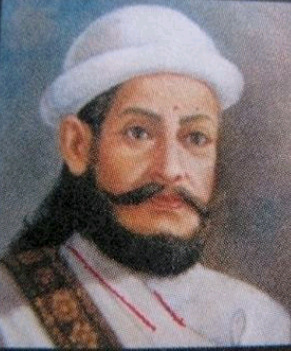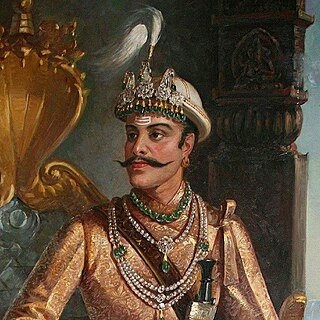Related Research Articles

Khatri is a caste originating from the Malwa and Majha areas of Punjab region of South Asia that is predominantly found in India, but also in Pakistan and Afghanistan. The Khatris claim they are warriors who took to trade. In the Indian subcontinent, they were mostly engaged in mercantile professions such as banking and trade. They were the dominant commercial and financial administration class of late-medieval India. Some in Punjab often belonged to hereditary agriculturalist land-holding lineages, while others were engaged in artisanal occupations such as silk production and weaving.
Bhatia is a group of people and a caste found in Punjab, Sindh and Gujarat. Traditionally, they have been a trading and merchant community. The Bhatias primarily live in Northwestern India and Pakistan. The Bhatias, Lohanas and Khatris were similar communities and were known to intermarry. The Bhatias recruit Saraswat Brahmins as priests.

Amar Singh Thapa distinguished as Badakaji Amar Singh Thapa(Nepali: बडाकाजी अमर सिंह थापा), or Amar Singh Thapa The Elder, also known by the honorific name Bada Kaji or Budha Kaji, was a Gorkhali military general, governor and warlord in the Kingdom of Nepal. He was the overall commander of the Nepal Army in the conquest of Western Provinces and authoritative ruler of Kumaon, Garhwal in the Kingdom of Nepal. He was referred by the King of Nepal to have been deployed as Mukhtiyar of Western Provinces of Kumaon, Garhwal. He is often hailed as Living Tiger of Nepal and was posthumously regarded as one of the national heroes of Nepal, who led the Anglo-Nepalese War for the Gorkhali Army. Amarsingh Chowk Pokhara and Shree Amarsingh Model Higher Secondary School are named after Amar Singh Thapa.

Rajsamand Lake is a lake in the city of Rajsamand in the Rajsamand district of Indian state of Rajasthan, 67 km away from Udaipur. Built by Rana Raj Singh, it is approximately 1.75 miles (2.82 km) wide, 4 miles (6.4 km) long and 60 feet (18 m) deep. It was built across the Gomti river which originates from Sewantri, Kelwa and Tali rivers, with a catchment area of approximately 196 sq mi (510 km2).

The Prime Minister of Nepal is the head of government of Nepal. Together with their Council of Ministers, The Prime Minister exercises executive power in the country. The Prime Minister must enjoy the confidence in the Pratinidhi Sabha before being appointed by the President and shall resign if they are unable to retain the majority in the House.

Rana Bahadur Shah, King of Nepal was the third King of Nepal, he succeeded to the throne after the death of his father, King Pratap Singh Shah. He ruled under the regencies of his mother, Queen Rajendra Rajya Lakshmi Devi, and then of his uncle, Bahadur Shah. During this time, the kingdom was expanded by conquest to include the Garhwal and Kumaon regions, now part of India. He imprisoned his uncle, Bahadur Shah, who died in jail.
The Sikligar is a community found in the Indian states of Gujarat, Haryana, Rajasthan, and Punjab. By tradition, the Sikligar people specialized in the craft of making and polishing weapons. They are typically Hindu in Gujarat, Telangana, and Andhra Pradesh; Sikh in Punjab; and either Hindu and Sikh in Haryana.
Rana Jashraj was elevated to the name Veer Dada Jashraj and he was worshiped as kuladevata by the Lohana caste. In memory of Jashraj, Vasant Panchami is celebrated as a balidaani diwas of Veer Dada Jashraj.
The Amils are a Sindhi sub-group of Bhaiband Lohana. The word "Amil" has its origin in the Persian word "amal". Amils used to work in Administration in Government services.
Harkor is the Kuldevi of the Lohana clan. She is worshiped by Lohanas along with her brother Rana Jashraj.

Suryaputra Karn is an Indian historical epic television series, which premiered on 29 June 2015 on Sony Entertainment Television. Produced by Siddharth Kumar Tewary of Swastik Pictures, the series covers the life journey of Karna in the Mahabharata. The show starred Gautam Rode, Vishesh Bansal and Basant Bhatt as the lead character at various stages of his life.
The Guhilas of Medapata colloquially known as Guhilas of Mewar were a Rajput dynasty that ruled the Kingdom of Mewar region in present-day Rajasthan state of India. The Guhila kings initially ruled as Gurjara-Pratihara feudatories between the end of 8th and 9th centuries and later were independent in period of the early 10th century and allied themselves with the Rashtrakutas. Their capitals included Nagahrada (Nagda) and Aghata (Ahar). For this reason, they are also known as the Nagda-Ahar branch of the Guhilas.
Banvir, also known as Banbeer was the ruler of Mewar Kingdom between 1536 and 1540. He was nephew of Rana Sanga, born to his brother Prithviraj and his cocunbine.
Kaal Bhairav Rahasya is an Indian thriller television series. The series ran for two seasons from October 2017 to April 2019. Both seasons are based on written works of Indra Soundarrajan. The story of the first season is based on his Tamil novel A Secret , The second season story is based on the supernatural thriller tale of Soundarrajan titled The Palace of Kottaipuram . The series features different cast in each season although many cast members appeared in both seasons as different characters.

The Pande family or Pande dynasty was a Chhetri political family with ancestral roots from Gorkha Kingdom that directly ruled Nepali administration, affairs from the 16th century to 19th century as Mulkaji and Mukhtiyar. This dynasty/family was one of the four noble families to be involved in active politics of Nepal together with the Shah dynasty, Basnyat family and Thapa dynasty before the rise of the Rana dynasty. The Pande dynasty is the oldest noble family to hold the title of Kaji. This family was decimated from political power in 1843 CE in the political massacre by Prime Minister Mathabar Singh Thapa as a revenge for his uncle Bhimsen's death in 1839.

Chandragupta Maurya is an Indian historical television show that aired on Sony TV from 14 November 2018 to 30 August 2019. Written by Raj Routh, the show is based on the life of Chandragupta Maurya, the first Mauryan emperor and founder of the Maurya Empire. The show is produced by Siddharth Kumar Tewary's One Life Studios.

The Kingdom of Gour was one of the greater of the many petty kingdoms of the medieval Sylhet region. According to legend, it was founded by Gurak, off-shooting from Kamarupa's Jaintia Kingdom in 630. Much of its early history is considered legendary or mythological up until Navagirvana who is mentioned in the Bhatera copper-plate inscriptions. The Kings of Gour are described as patrons of Hindu revivalism in what was previously a predominantly Buddhist and animist populated land.
Mahesha Thakura was the ruler of Mithila in the 16th century. He made his capital in the northwest of Sarisab-Pahi and Rajgram. He was also wrote some treatises and commentaries on astronomy and Indian philosophy. He was gifted the Kingdom of Mithila for his scholarly wisdom by the Mughal emperor. He established the Khandwala dynasty in Mithila, later known as Raj Darbhanga, in 1527.
References
- ↑ Lohanas in Diaspora
- ↑ Singh, Kumar Suresh (2003). Gujrat Part 1 by Kumar Suresh Singh, Anthropological Survey of India. Popular Prakashan. p. 769. ISBN 9788179911044.